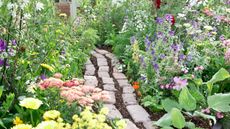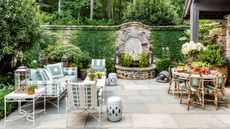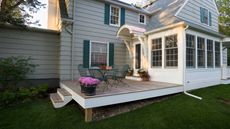Ideas
Garden ideas and inspiration to help you make the most of your outdoor space
Latest
-

24 balcony lighting ideas to create a cozy outdoor atmosphere
Ideas Our beautiful balcony lighting ideas will give you lots of inspiration to brighten up your space throughout the year
By Flora Baker Published
-

The new 2023 garden trends to get excited by – and recreate in your backyard
Ideas These stylish new garden trends for 2023 are all you need to put your dream outdoor space together
By Holly Crossley Last updated
-

24 indoor planter ideas to instantly brighten up your home
Ideas Elevate your interior scheme and show off your favorite houseplants with these gorgeous indoor planter ideas
By Flora Baker Published
-

Pizza oven tables: 16 looks for a stylish outdoor setup
Ideas Cook up a storm on the best steel, wheeled, and specialist pizza oven tables around
By Flora Baker Published
-

The Christmas terrarium trend is a must-try for plant lovers – we reveal the secrets for creating one at home
Ideas Try designing a Christmas terrarium – it's the new must-have holiday decoration and is so easy to do
By Sarah Wilson Published
-

Desert landscaping ideas: 8 stunning ways to create a verdant oasis in your yard
Ideas Our edit of desert landscaping ideas is full of expert tips to help you bring out the best in a hot and arid environment
By Sarah Wilson Published
-

10 beautiful, low-maintenance xeriscape ideas to recreate at home
Ideas Try these xeriscape ideas to transform your yard into an easy-care, low-water landscape
By Zia Allaway Published
-

Japanese garden ideas: 14 ways to create a tranquil space with landscaping and plants
Ideas Breathe new life into your plot with these Japanese garden ideas – low maintenance and full of year-round interest, they’ll add a touch of calm serenity too
By Jill Morgan Last updated
-

How to create a Santa's grotto in your yard: 24 fun ideas for lighting, decorations and more
How To Learn how to create a Santa's grotto in your yard for a fun-filled holiday season for all the family
By Sarah Wilson Published
-

Why we love the boxwood wreath trend and how you can recreate it at home
Ideas Go for an elegant, evergreen look with a boxwood wreath – the new must-have holiday decoration
By Holly Crossley Published
-

8 Christmas flower arrangement trends I'm copying from professional florists this year
Ideas Choose from these inspirational Christmas flower arrangement ideas from top florists and spruce up your festive decor with brilliant blooms
By Sarah Wilson Published
-

Cozy balcony ideas: 24 looks to create your perfect outdoor aesthetic
Ideas These cozy balcony ideas will help you enjoy your small outside space all year round
By Flora Baker Published
-

Pine cone Christmas craft ideas: 9 festive decorations to try
Ideas Make these pine cone Christmas craft ideas and enjoy an eco-friendly holiday
By Flora Baker Published
-

Outdoor Christmas decor ideas: 32 fabulously festive looks for your backyard
Ideas Our edit of outdoor Christmas decor ideas will help transform your garden into a winter wonderland this holiday season
By Holly Crossley Published
-

Christmas window lighting ideas: 10 ways to brighten up your home this holiday season
Ideas We've rounded up our favorite Christmas window lighting ideas for spreading festive cheer
By Holly Crossley Published
-

The gnome Christmas tree trend we'll be recreating this holiday season
Ideas Add a gnome Christmas tree to your festive decor – the perfect way to spread festive cheer
By Holly Crossley Published
-

Bonfire Night ideas: 13 suggestions for memorable get-togethers outdoors
Ideas Our Bonfire Night ideas will get you prepared for a magical celebration this autumn
By Holly Crossley Published
-

Christmas door decor ideas: 11 ways to create a festive welcome
Ideas From chic and simple to all-out bling – our Christmas door decor ideas will transform your home’s front entrance ready for the holiday season
By Jill Morgan Published
-

Xeriscaping: this landscaping technique will transform the way you garden
Landscaping Discover xeriscaping and create a beautiful, easy-care, environmentally-friendly yard that will save you money
By Zia Allaway Published
-

Cheap DIY garden path ideas: 10 ways to build a path for less
Ideas These cheap DIY garden path ideas prove you don’t have to spend a fortune to make an impact on your outdoor space
By Jayne Dowle Published
-

Front yard lighting ideas: 8 ways to give your home a welcoming glow
Ideas Our front yard lighting ideas are not just stylish – they're good for increasing your plot's security levels, too
By Holly Crossley Last updated
-

Fire pit ideas: 20 ways to cozy up after dark and create an enchanting atmosphere
Ideas Elevate your evenings spent outdoors with our favorite fire pit ideas, from rustic bowls to contemporary designs
By Beth Murton Last updated
-

Landscaping with lights: 16 enchanting ways to illuminate your space
Ideas Landscaping with lights will transform any backyard into a dramatic and atmospheric nighttime scene
By Holly Crossley Last updated
-

Paving ideas for small gardens: 12 options for compact yards
Ideas Small backyard? No problem. These paving ideas for small gardens will help you create an outdoor living space which oozes style
By Teresa Conway Published
-

Halloween porch decor: 14 ways to welcome trick-or-treaters in style
Ideas Our Halloween porch decor ideas will provide all the inspiration you need to transform the entrance of your home into a spooktacular scene
By Holly Crossley Last updated
-

Outdoor Halloween decor ideas: 16 spooky yet stylish ways to dress up your plot
Ideas These outdoor Halloween decor ideas will inspire your backyard makeover in time for the holiday season – including lighting, accessories, and pumpkin displays
By Holly Crossley Published
-

10 easy no carve pumpkin ideas for your fall decor
Ideas Learn some new no carve pumpkin ideas and branch out with your creative displays – no knives needed!
By Flora Baker Published
-

Flagstone patio ideas: 11 ways to add one to your backyard
Ideas These stylish flagstone patio ideas are a great way to give backyards big and small the focal point they deserve
By Jayne Dowle Published
-

DIY deck ideas: 10 stylish projects to update your outdoor living space
Ideas These DIY deck ideas will breathe new life into your plot for an affordable price
By Holly Crossley Published

